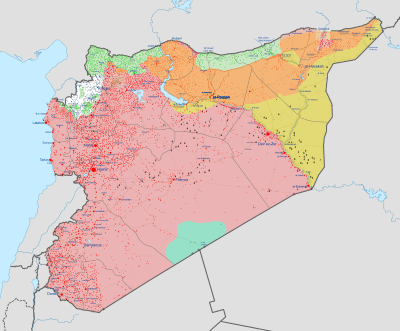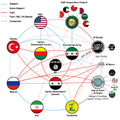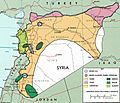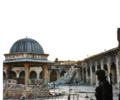Syrian civil war facts for kids
The Syrian civil war is an ongoing multi-sided conflict in Syria. In March 2011, popular discontent with the Ba'athist regime ruled by Bashar al-Assad triggered large-scale protests and pro-democracy rallies across Syria, as part of the wider Arab Spring protests in the region. After months of crackdown by the government's security apparatus, various armed rebel groups such as the Free Syrian Army began forming across the country, marking the beginning of the Syrian insurgency. By mid-2012, the insurgency had escalated into a full-blown civil war.
Rebel forces, which received arms from Gulf Cooperation Council states, Turkey and some Western countries, initially made significant advances against the government forces, which were receiving financial and military support from Iran and Russia. Rebels captured the regional capitals of Raqqa in 2013 and Idlib in 2015. Consequently, Iran launched a military intervention in support of the Syrian government in 2014 and Russia followed in 2015, shifting the balance of the conflict. By late 2018, all rebel strongholds except parts of Idlib region had fallen to the government forces.
In 2014, the Islamic State won many battles against both the rebel factions and the Syrian government. Combined with simultaneous success in Iraq, the group was able to seize control of large parts of Eastern Syria and Western Iraq, prompting the US-led CJTF coalition to launch an aerial bombing campaign against it, while providing ground support and supplies to the Kurdish-majority Syrian Democratic Forces. By way of battles that culminated in the Raqqa and Deir ez-Zor offensives, the Islamic State was territorially defeated by late 2017. In August 2016, Turkey launched a multi-pronged invasion of northern Syria, in response to the creation of Rojava, while also fighting the Islamic State and government forces in the process. Between the March 2020 Idlib ceasefire and late 2024, frontline fighting mostly subsided, but there were regular skirmishes.
Heavy fighting renewed with a major rebel offensive in the northwest led by Tahrir al-Sham and supported by allied groups in the Turkish-backed Syrian National Army in November 2024, during which Aleppo, Hama and Homs were seized. Southern rebels who had previously reconciled with the government subsequently launched their own offensive, capturing Daraa and Suwayda. The Syrian Free Army and the Syrian Democratic Forces launched their own offensives in Palmyra and Deir ez-Zor, respectively. By 8 December, rebel forces had seized the capital, Damascus. Following this, the Assad regime collapsed, with al-Assad fleeing to Moscow. On the same day, Israel launched an invasion of Syria's Quneitra Governorate, aiming to seize the UN buffer zone in the Golan Heights. The SNA continued to clash with the SDF in and around Aleppo.
Contents
Overview
Origins of the conflict (2011–2012)
In March 2011, popular discontent with President Bashar al-Assad's Ba'athist government led to large-scale protests and pro-democracy rallies across Syria, as part of the wider Arab Spring protests in the region. Numerous protests were violently suppressed by security forces in deadly crackdowns ordered by Assad, resulting in tens of thousands of deaths and detentions, many of whom were civilians. The Syrian revolution transformed into an insurgency with the formation of resistance militias across the country, developing into a full civil war by 2012.
Stalemate and frozen conflict (2020–2024)
Following the March 2020 Idlib ceasefire, frontline fighting between the Syrian government under Assad and opposition groups had mostly subsided. By 2021, the Assad government controlled about two-thirds of the country and was consolidating power. Although, regular flare-ups occurred among factions in northwestern Syria, and large-scale protests emerged in southern Syria and spread nationwide in response to extensive autocratic policies and the economic situation. The protests were noted at the time as resembling the 2011 revolution that preceded the civil war.
The civil war had largely settled into a stalemate by early 2023.
Renewed rebel offensives and fall of the Assad regime (2024)
On 27 November 2024, a coalition of opposition groups called the Military Operations Command, led by Hay'at Tahrir al-Sham, launched a major offensive against the Syrian Army and other pro-government forces in Aleppo, Idlib, Hama and Homs Governorates. This was followed by other rebel offensives from the Southern Operations Room, the SDF and the Syrian Free Army which all began seizing Syrian government territory in the country's south and east. On 29 November, rebel forces entered Aleppo as Syrian Army positions collapsed across the country. On 7 December, rebel forces entered Damascus and the next day, on 8 December, Bashar al-Assad was reported to have fled the capital. The Syrian Army confirmed Assad was no longer in power and had fled the country, resulting in the collapse of his regime and ending over 60 years of Ba'athist rule under the Assad dynasty. Assad and his family had fled to Moscow and was granted asylum in Russia. Syrian Prime Minister Mohammad Ghazi al-Jalali announced his willingness to cooperate with any new leadership "chosen by the people".
The Syrian Salvation Government established a transitional government in Damascus, with Mohammed al-Bashir serving as the prime minister during the transition, succeeding al-Jalali. Ahmed al-Sharaa, the leader of the Syrian Salvation Government and emir of Hay'at Tahrir al-Sham, became de facto leader of Syria.
On 8 December 2024, Israel invaded southern Syria, subsuming the Golan Heights buffer zone and capturing Quneitra, the Syrian portion of Mount Hermon, and surrounding towns and villages. Israel also launched a strategic bombing campaign against remnant Syrian Armed Forces airbases, air defense networks, missile systems, coastal defense installations, naval assets, weapons storage and production facilities and alleged chemical weapons stockpiles to neutralize Assad's former military assets.
Images for kids
-
Esther Brimmer (US) speaks at a United Nations Human Rights Council urgent debate on Syria, February 2012
See also
 In Spanish: Guerra civil siria para niños
In Spanish: Guerra civil siria para niños



















